Analysis of European Financial Market and Trilemma Issues
VerifiedAdded on 2019/10/31
|6
|1042
|184
Report
AI Summary
This report provides an analysis of the European financial market, specifically focusing on the financial integration trilemma. It explains the incompatibility of cross-border financial integration, financial stability, and national financial policies, highlighting the challenges faced by the European Union. The report discusses the 2007-2009 economic crisis and its impact on financial stability, the role of the ECB, and the concept of systematic risks. It examines the financial policy trilemma based on the IS-LM model and discusses the relationship between domestic and foreign interest rates. Furthermore, the report analyzes the increasing cross-border penetration in the European banking sector and the integration of financial institutions, particularly large ones. The report concludes by emphasizing the sacrifices that must be made in the European Union in order to maintain financial stability and national financial policies. The report also includes relevant bibliography for further reading.
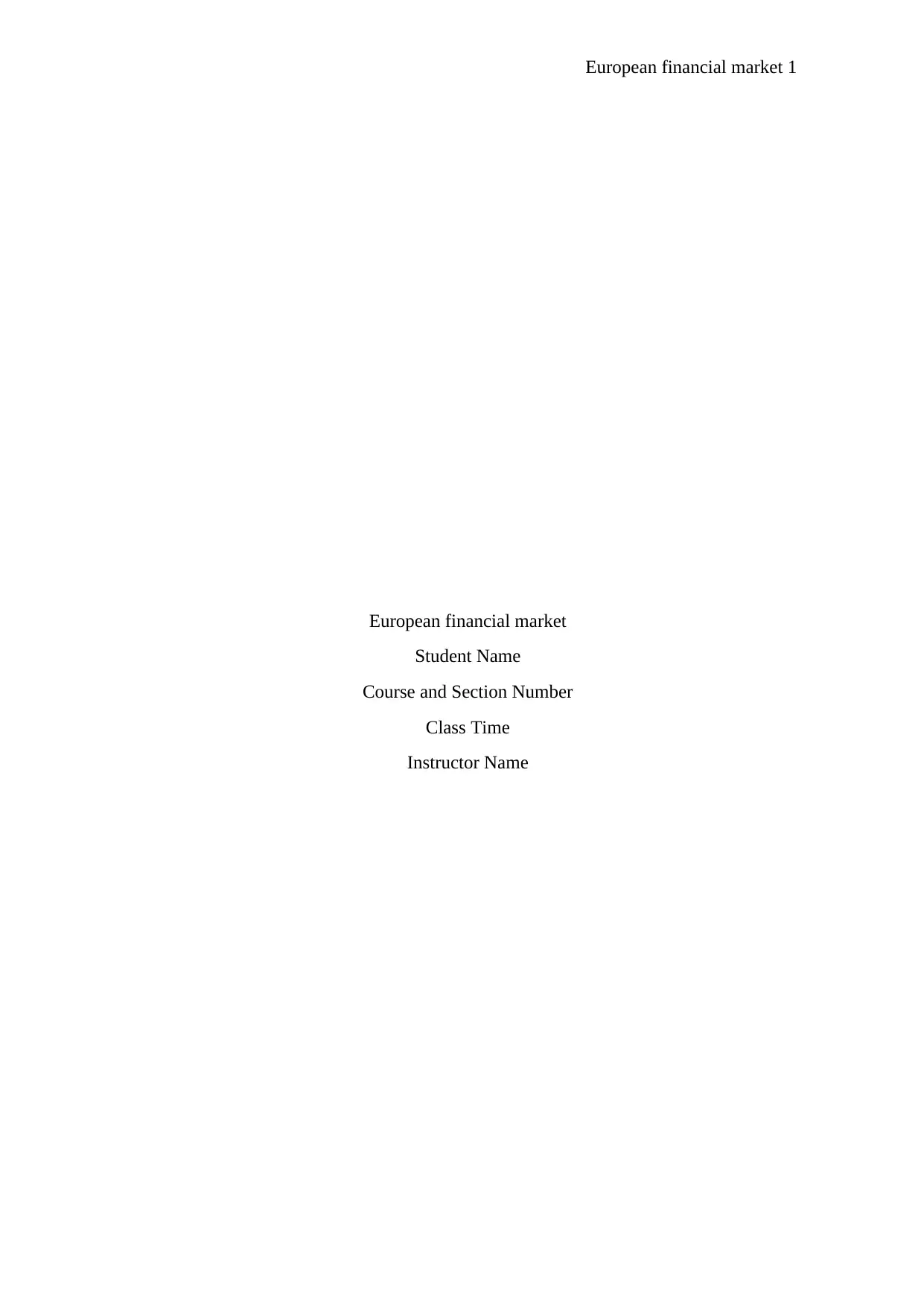
European financial market 1
European financial market
Student Name
Course and Section Number
Class Time
Instructor Name
European financial market
Student Name
Course and Section Number
Class Time
Instructor Name
Paraphrase This Document
Need a fresh take? Get an instant paraphrase of this document with our AI Paraphraser
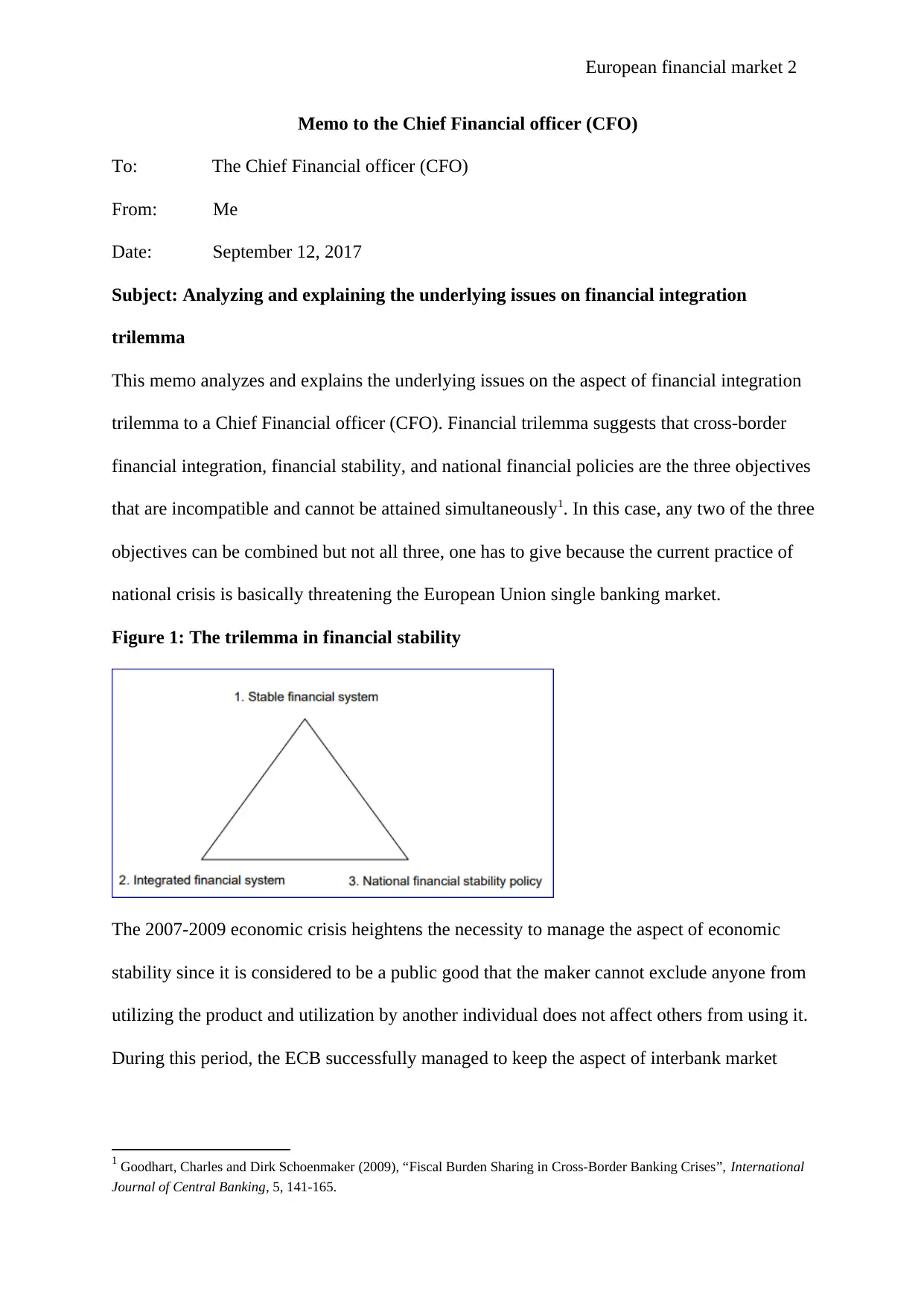
European financial market 2
Memo to the Chief Financial officer (CFO)
To: The Chief Financial officer (CFO)
From: Me
Date: September 12, 2017
Subject: Analyzing and explaining the underlying issues on financial integration
trilemma
This memo analyzes and explains the underlying issues on the aspect of financial integration
trilemma to a Chief Financial officer (CFO). Financial trilemma suggests that cross-border
financial integration, financial stability, and national financial policies are the three objectives
that are incompatible and cannot be attained simultaneously1. In this case, any two of the three
objectives can be combined but not all three, one has to give because the current practice of
national crisis is basically threatening the European Union single banking market.
Figure 1: The trilemma in financial stability
The 2007-2009 economic crisis heightens the necessity to manage the aspect of economic
stability since it is considered to be a public good that the maker cannot exclude anyone from
utilizing the product and utilization by another individual does not affect others from using it.
During this period, the ECB successfully managed to keep the aspect of interbank market
1 Goodhart, Charles and Dirk Schoenmaker (2009), “Fiscal Burden Sharing in Cross-Border Banking Crises”, International
Journal of Central Banking, 5, 141-165.
Memo to the Chief Financial officer (CFO)
To: The Chief Financial officer (CFO)
From: Me
Date: September 12, 2017
Subject: Analyzing and explaining the underlying issues on financial integration
trilemma
This memo analyzes and explains the underlying issues on the aspect of financial integration
trilemma to a Chief Financial officer (CFO). Financial trilemma suggests that cross-border
financial integration, financial stability, and national financial policies are the three objectives
that are incompatible and cannot be attained simultaneously1. In this case, any two of the three
objectives can be combined but not all three, one has to give because the current practice of
national crisis is basically threatening the European Union single banking market.
Figure 1: The trilemma in financial stability
The 2007-2009 economic crisis heightens the necessity to manage the aspect of economic
stability since it is considered to be a public good that the maker cannot exclude anyone from
utilizing the product and utilization by another individual does not affect others from using it.
During this period, the ECB successfully managed to keep the aspect of interbank market
1 Goodhart, Charles and Dirk Schoenmaker (2009), “Fiscal Burden Sharing in Cross-Border Banking Crises”, International
Journal of Central Banking, 5, 141-165.
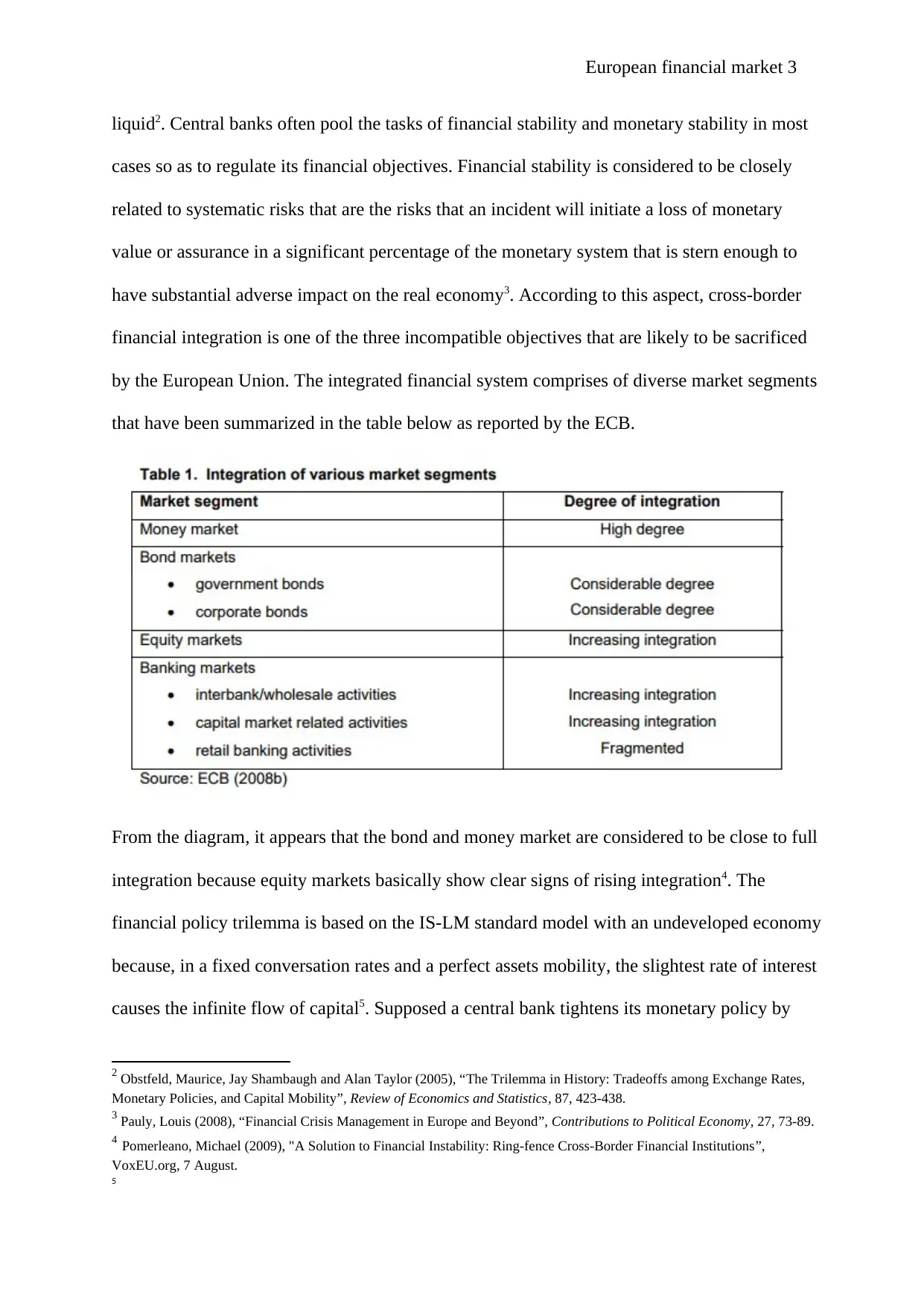
European financial market 3
liquid2. Central banks often pool the tasks of financial stability and monetary stability in most
cases so as to regulate its financial objectives. Financial stability is considered to be closely
related to systematic risks that are the risks that an incident will initiate a loss of monetary
value or assurance in a significant percentage of the monetary system that is stern enough to
have substantial adverse impact on the real economy3. According to this aspect, cross-border
financial integration is one of the three incompatible objectives that are likely to be sacrificed
by the European Union. The integrated financial system comprises of diverse market segments
that have been summarized in the table below as reported by the ECB.
From the diagram, it appears that the bond and money market are considered to be close to full
integration because equity markets basically show clear signs of rising integration4. The
financial policy trilemma is based on the IS-LM standard model with an undeveloped economy
because, in a fixed conversation rates and a perfect assets mobility, the slightest rate of interest
causes the infinite flow of capital5. Supposed a central bank tightens its monetary policy by
2 Obstfeld, Maurice, Jay Shambaugh and Alan Taylor (2005), “The Trilemma in History: Tradeoffs among Exchange Rates,
Monetary Policies, and Capital Mobility”, Review of Economics and Statistics, 87, 423-438.
3 Pauly, Louis (2008), “Financial Crisis Management in Europe and Beyond”, Contributions to Political Economy, 27, 73-89.
4 Pomerleano, Michael (2009), "A Solution to Financial Instability: Ring-fence Cross-Border Financial Institutions”,
VoxEU.org, 7 August.
5
liquid2. Central banks often pool the tasks of financial stability and monetary stability in most
cases so as to regulate its financial objectives. Financial stability is considered to be closely
related to systematic risks that are the risks that an incident will initiate a loss of monetary
value or assurance in a significant percentage of the monetary system that is stern enough to
have substantial adverse impact on the real economy3. According to this aspect, cross-border
financial integration is one of the three incompatible objectives that are likely to be sacrificed
by the European Union. The integrated financial system comprises of diverse market segments
that have been summarized in the table below as reported by the ECB.
From the diagram, it appears that the bond and money market are considered to be close to full
integration because equity markets basically show clear signs of rising integration4. The
financial policy trilemma is based on the IS-LM standard model with an undeveloped economy
because, in a fixed conversation rates and a perfect assets mobility, the slightest rate of interest
causes the infinite flow of capital5. Supposed a central bank tightens its monetary policy by
2 Obstfeld, Maurice, Jay Shambaugh and Alan Taylor (2005), “The Trilemma in History: Tradeoffs among Exchange Rates,
Monetary Policies, and Capital Mobility”, Review of Economics and Statistics, 87, 423-438.
3 Pauly, Louis (2008), “Financial Crisis Management in Europe and Beyond”, Contributions to Political Economy, 27, 73-89.
4 Pomerleano, Michael (2009), "A Solution to Financial Instability: Ring-fence Cross-Border Financial Institutions”,
VoxEU.org, 7 August.
5
⊘ This is a preview!⊘
Do you want full access?
Subscribe today to unlock all pages.

Trusted by 1+ million students worldwide
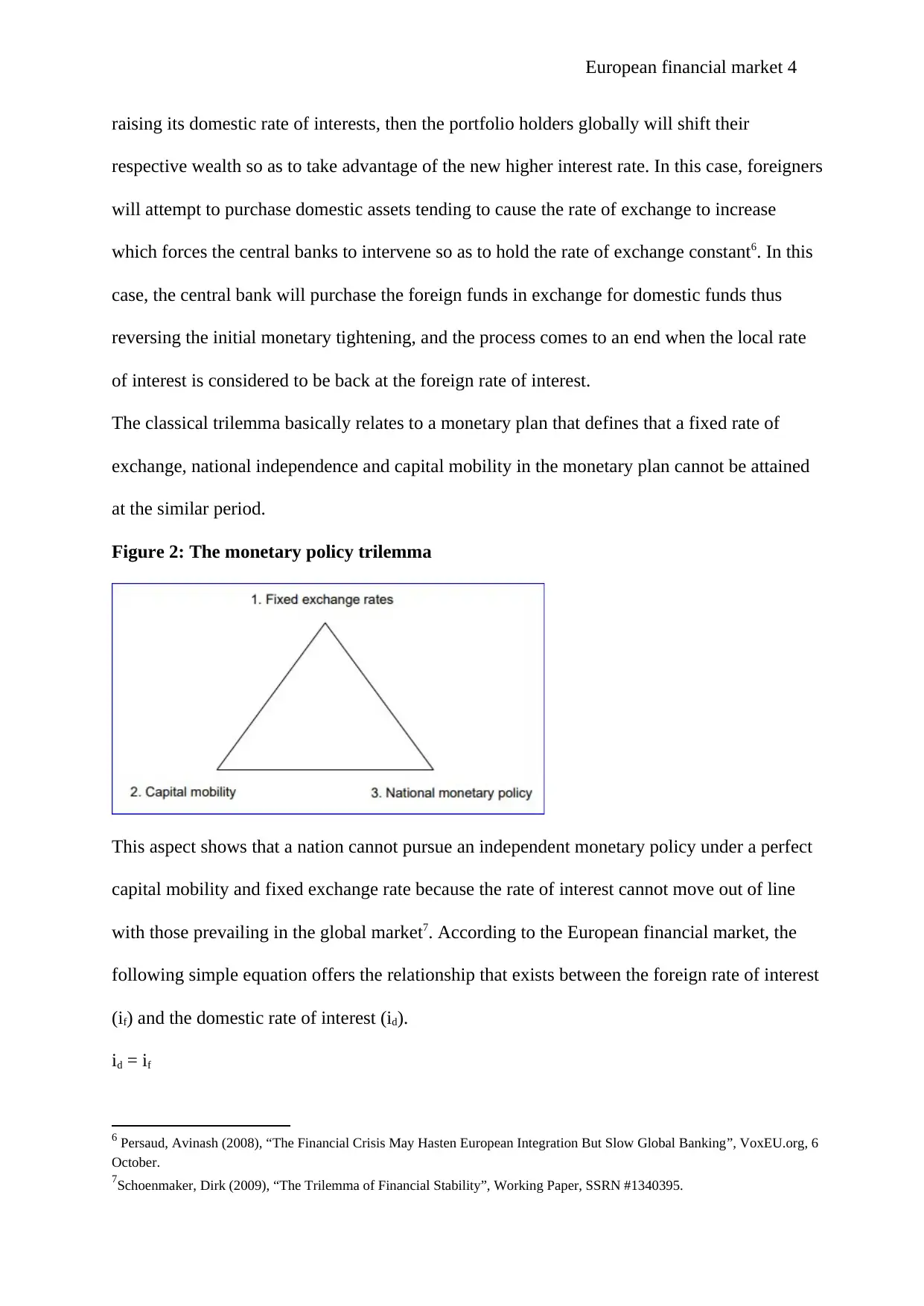
European financial market 4
raising its domestic rate of interests, then the portfolio holders globally will shift their
respective wealth so as to take advantage of the new higher interest rate. In this case, foreigners
will attempt to purchase domestic assets tending to cause the rate of exchange to increase
which forces the central banks to intervene so as to hold the rate of exchange constant6. In this
case, the central bank will purchase the foreign funds in exchange for domestic funds thus
reversing the initial monetary tightening, and the process comes to an end when the local rate
of interest is considered to be back at the foreign rate of interest.
The classical trilemma basically relates to a monetary plan that defines that a fixed rate of
exchange, national independence and capital mobility in the monetary plan cannot be attained
at the similar period.
Figure 2: The monetary policy trilemma
This aspect shows that a nation cannot pursue an independent monetary policy under a perfect
capital mobility and fixed exchange rate because the rate of interest cannot move out of line
with those prevailing in the global market7. According to the European financial market, the
following simple equation offers the relationship that exists between the foreign rate of interest
(if) and the domestic rate of interest (id).
id = if
6 Persaud, Avinash (2008), “The Financial Crisis May Hasten European Integration But Slow Global Banking”, VoxEU.org, 6
October.
7Schoenmaker, Dirk (2009), “The Trilemma of Financial Stability”, Working Paper, SSRN #1340395.
raising its domestic rate of interests, then the portfolio holders globally will shift their
respective wealth so as to take advantage of the new higher interest rate. In this case, foreigners
will attempt to purchase domestic assets tending to cause the rate of exchange to increase
which forces the central banks to intervene so as to hold the rate of exchange constant6. In this
case, the central bank will purchase the foreign funds in exchange for domestic funds thus
reversing the initial monetary tightening, and the process comes to an end when the local rate
of interest is considered to be back at the foreign rate of interest.
The classical trilemma basically relates to a monetary plan that defines that a fixed rate of
exchange, national independence and capital mobility in the monetary plan cannot be attained
at the similar period.
Figure 2: The monetary policy trilemma
This aspect shows that a nation cannot pursue an independent monetary policy under a perfect
capital mobility and fixed exchange rate because the rate of interest cannot move out of line
with those prevailing in the global market7. According to the European financial market, the
following simple equation offers the relationship that exists between the foreign rate of interest
(if) and the domestic rate of interest (id).
id = if
6 Persaud, Avinash (2008), “The Financial Crisis May Hasten European Integration But Slow Global Banking”, VoxEU.org, 6
October.
7Schoenmaker, Dirk (2009), “The Trilemma of Financial Stability”, Working Paper, SSRN #1340395.
Paraphrase This Document
Need a fresh take? Get an instant paraphrase of this document with our AI Paraphraser
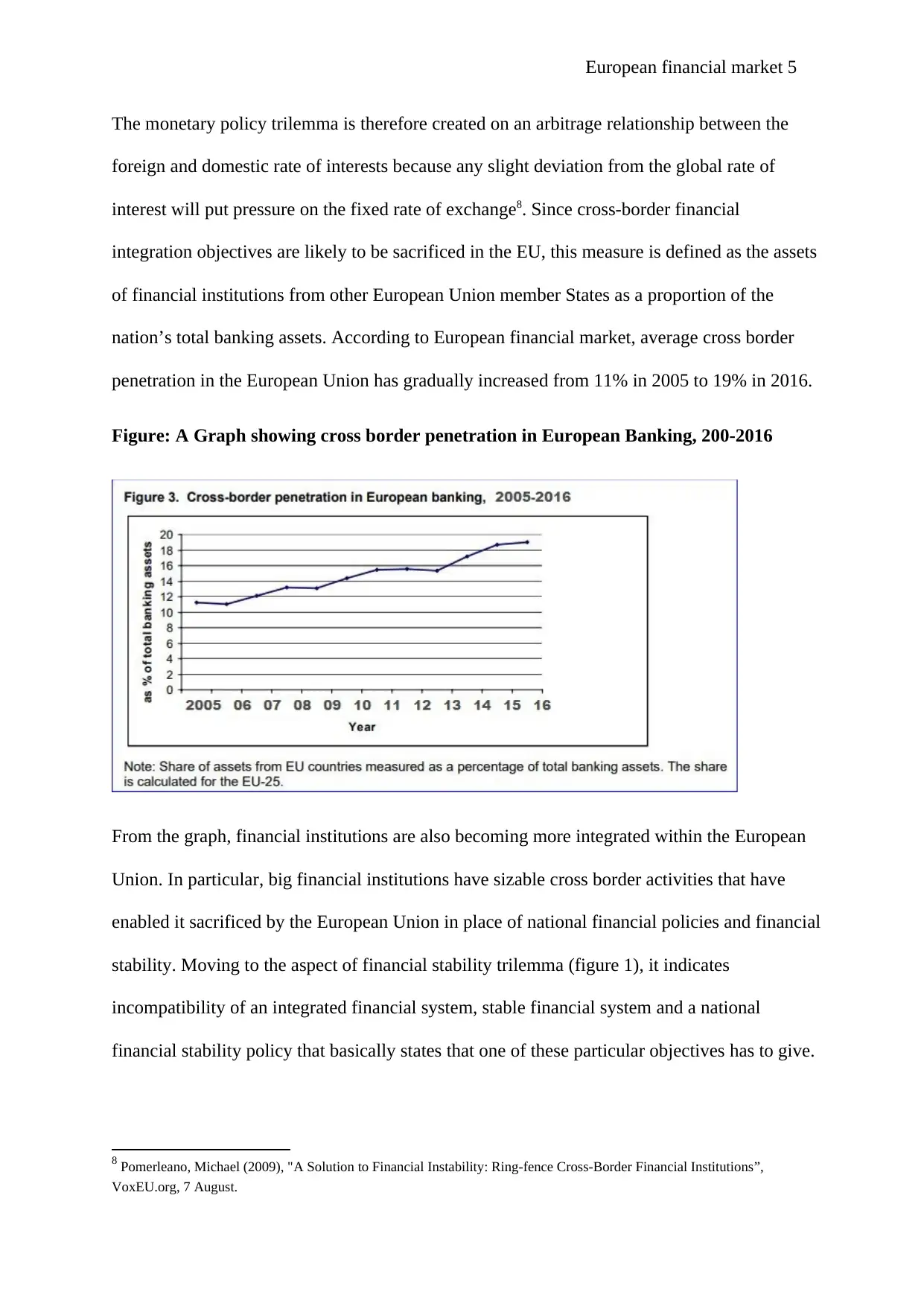
European financial market 5
The monetary policy trilemma is therefore created on an arbitrage relationship between the
foreign and domestic rate of interests because any slight deviation from the global rate of
interest will put pressure on the fixed rate of exchange8. Since cross-border financial
integration objectives are likely to be sacrificed in the EU, this measure is defined as the assets
of financial institutions from other European Union member States as a proportion of the
nation’s total banking assets. According to European financial market, average cross border
penetration in the European Union has gradually increased from 11% in 2005 to 19% in 2016.
Figure: A Graph showing cross border penetration in European Banking, 200-2016
From the graph, financial institutions are also becoming more integrated within the European
Union. In particular, big financial institutions have sizable cross border activities that have
enabled it sacrificed by the European Union in place of national financial policies and financial
stability. Moving to the aspect of financial stability trilemma (figure 1), it indicates
incompatibility of an integrated financial system, stable financial system and a national
financial stability policy that basically states that one of these particular objectives has to give.
8 Pomerleano, Michael (2009), "A Solution to Financial Instability: Ring-fence Cross-Border Financial Institutions”,
VoxEU.org, 7 August.
The monetary policy trilemma is therefore created on an arbitrage relationship between the
foreign and domestic rate of interests because any slight deviation from the global rate of
interest will put pressure on the fixed rate of exchange8. Since cross-border financial
integration objectives are likely to be sacrificed in the EU, this measure is defined as the assets
of financial institutions from other European Union member States as a proportion of the
nation’s total banking assets. According to European financial market, average cross border
penetration in the European Union has gradually increased from 11% in 2005 to 19% in 2016.
Figure: A Graph showing cross border penetration in European Banking, 200-2016
From the graph, financial institutions are also becoming more integrated within the European
Union. In particular, big financial institutions have sizable cross border activities that have
enabled it sacrificed by the European Union in place of national financial policies and financial
stability. Moving to the aspect of financial stability trilemma (figure 1), it indicates
incompatibility of an integrated financial system, stable financial system and a national
financial stability policy that basically states that one of these particular objectives has to give.
8 Pomerleano, Michael (2009), "A Solution to Financial Instability: Ring-fence Cross-Border Financial Institutions”,
VoxEU.org, 7 August.
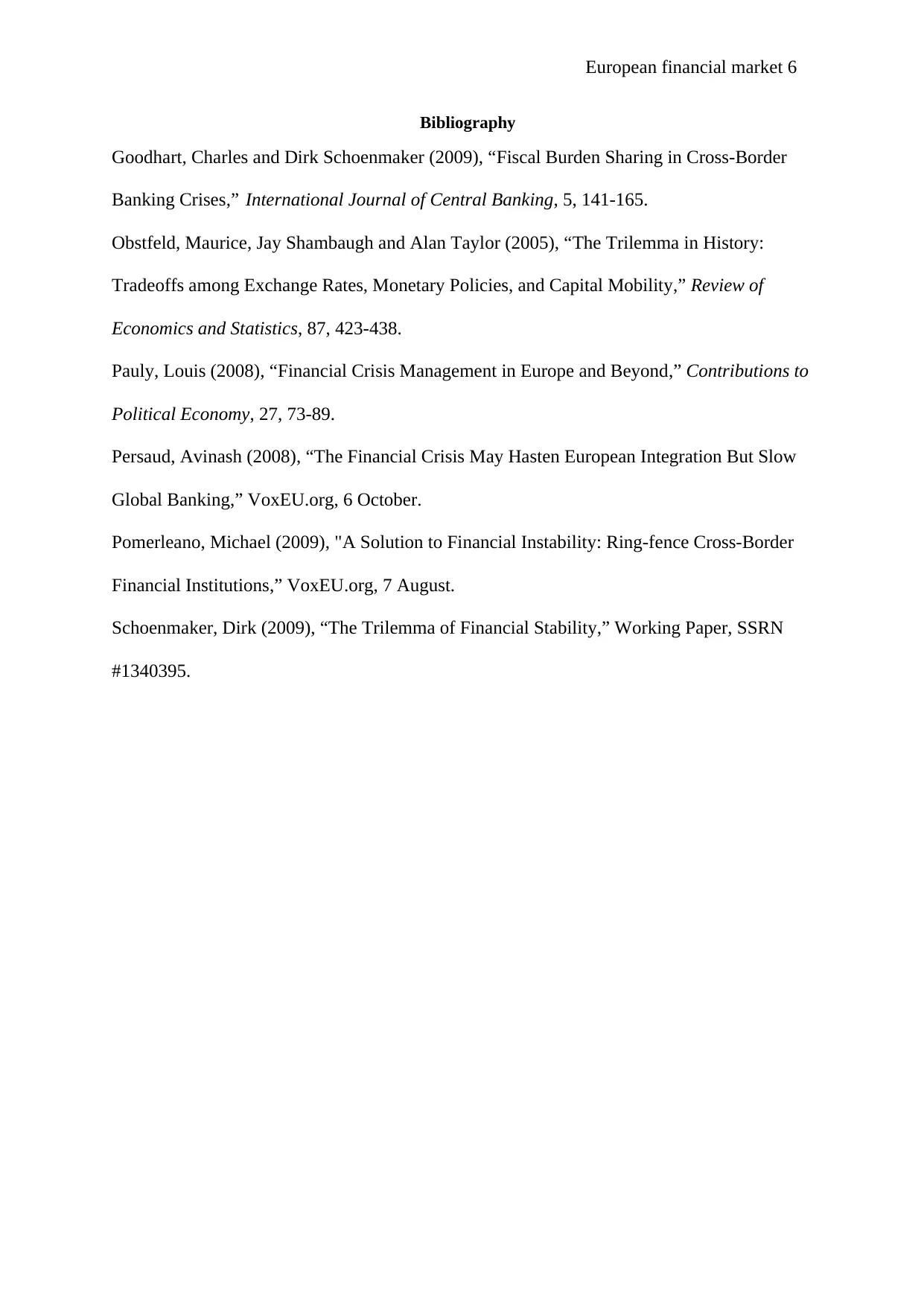
European financial market 6
Bibliography
Goodhart, Charles and Dirk Schoenmaker (2009), “Fiscal Burden Sharing in Cross-Border
Banking Crises,” International Journal of Central Banking, 5, 141-165.
Obstfeld, Maurice, Jay Shambaugh and Alan Taylor (2005), “The Trilemma in History:
Tradeoffs among Exchange Rates, Monetary Policies, and Capital Mobility,” Review of
Economics and Statistics, 87, 423-438.
Pauly, Louis (2008), “Financial Crisis Management in Europe and Beyond,” Contributions to
Political Economy, 27, 73-89.
Persaud, Avinash (2008), “The Financial Crisis May Hasten European Integration But Slow
Global Banking,” VoxEU.org, 6 October.
Pomerleano, Michael (2009), "A Solution to Financial Instability: Ring-fence Cross-Border
Financial Institutions,” VoxEU.org, 7 August.
Schoenmaker, Dirk (2009), “The Trilemma of Financial Stability,” Working Paper, SSRN
#1340395.
Bibliography
Goodhart, Charles and Dirk Schoenmaker (2009), “Fiscal Burden Sharing in Cross-Border
Banking Crises,” International Journal of Central Banking, 5, 141-165.
Obstfeld, Maurice, Jay Shambaugh and Alan Taylor (2005), “The Trilemma in History:
Tradeoffs among Exchange Rates, Monetary Policies, and Capital Mobility,” Review of
Economics and Statistics, 87, 423-438.
Pauly, Louis (2008), “Financial Crisis Management in Europe and Beyond,” Contributions to
Political Economy, 27, 73-89.
Persaud, Avinash (2008), “The Financial Crisis May Hasten European Integration But Slow
Global Banking,” VoxEU.org, 6 October.
Pomerleano, Michael (2009), "A Solution to Financial Instability: Ring-fence Cross-Border
Financial Institutions,” VoxEU.org, 7 August.
Schoenmaker, Dirk (2009), “The Trilemma of Financial Stability,” Working Paper, SSRN
#1340395.
⊘ This is a preview!⊘
Do you want full access?
Subscribe today to unlock all pages.

Trusted by 1+ million students worldwide
1 out of 6
Related Documents
Your All-in-One AI-Powered Toolkit for Academic Success.
+13062052269
info@desklib.com
Available 24*7 on WhatsApp / Email
![[object Object]](/_next/static/media/star-bottom.7253800d.svg)
Unlock your academic potential
Copyright © 2020–2025 A2Z Services. All Rights Reserved. Developed and managed by ZUCOL.





